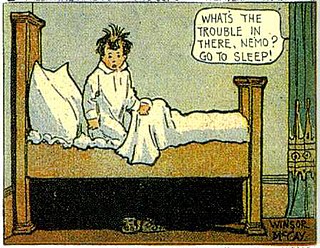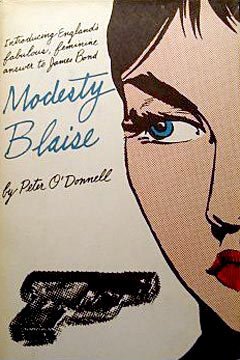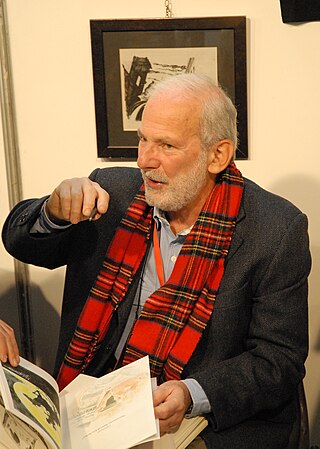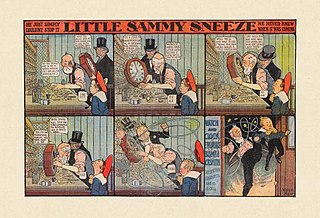
Little Nemo is a fictional character created by American cartoonist Winsor McCay. He originated in an early comic strip by McCay, Dream of the Rarebit Fiend, before receiving his own spin-off series, Little Nemo in Slumberland. The full-page weekly strip depicted Nemo having fantastic dreams that were interrupted by his awakening in the final panel. The strip is considered McCay's masterpiece for its experiments with the form of the comics page, its use of color and perspective, its timing and pacing, the size and shape of its panels, and its architectural and other details.

The Yellow Kid is an American comic strip character that appeared from 1895 to 1898 in Joseph Pulitzer's New York World, and later William Randolph Hearst's New York Journal. Created and drawn by Richard F. Outcault in the comic strip Hogan's Alley, it was one of the first Sunday supplement comic strips in an American newspaper, although its graphical layout had already been thoroughly established in political and other, purely-for-entertainment cartoons. Outcault's use of word balloons in the Yellow Kid influenced the basic appearance and use of balloons in subsequent newspaper comic strips and comic books.

Zenas Winsor McCay was an American cartoonist and animator. He is best known for the comic strip Little Nemo and the animated film Gertie the Dinosaur (1914). For contractual reasons, he worked under the pen name Silas on the comic strip Dream of the Rarebit Fiend.

Dream of the Rarebit Fiend is a newspaper comic strip by American cartoonist Winsor McCay, begun September 10, 1904. It was McCay's second successful strip, after Little Sammy Sneeze secured him a position on the cartoon staff of the New York Herald. Rarebit Fiend appeared in the Evening Telegram, a newspaper published by the Herald. For contractual reasons, McCay signed the strip with the pen name "Silas".

Jean Henri Gaston Giraud was a French artist, cartoonist and writer who worked in the Franco-Belgian bandes dessinées (BD) tradition. Giraud garnered worldwide acclaim predominantly under the pseudonym Mœbius for his fantasy/science-fiction work, and to a slightly lesser extent as Gir, which he used for the Blueberry series and his other Western themed work. Esteemed by Federico Fellini, Stan Lee, and Hayao Miyazaki, among others, he has been described as the most influential bande dessinée artist after Hergé.
Disney comics are comic books and comic strips featuring characters created by the Walt Disney Company, including Mickey Mouse, Donald Duck and Uncle Scrooge.

Modesty Blaise is a British comic strip featuring a fictional character of the same name, created by author Peter O'Donnell and illustrator Jim Holdaway in 1963. The strip follows Modesty Blaise, an exceptional young woman with many talents and a criminal past, and her trusty sidekick Willie Garvin. It was adapted into films in 1966, 1982, and 2003, and from 1965 onwards, 11 novels and two short-story collections were written.

Tank Girl is a British comic book character created by Alan Martin and Jamie Hewlett, and first appeared in print in 1988 in the British comics magazine Deadline. After a period of intense popularity in the late 1980s and early 1990s, Tank Girl inspired a 1995 feature film. After a long hiatus, the character returned to comics in 2007 and has appeared regularly in the years since.

Daniel Gillespie Clowes is an American cartoonist, graphic novelist, illustrator, and screenwriter. Most of Clowes's work first appeared in Eightball, a solo anthology comic book series. An Eightball issue typically contained several short pieces and a chapter of a longer narrative that was later collected and published as a graphic novel, such as Like a Velvet Glove Cast in Iron (1993), Ghost World (1997), David Boring (2000) and Patience (2016). Clowes's illustrations have appeared in The New Yorker, Newsweek, Vogue, The Village Voice, and elsewhere. With filmmaker Terry Zwigoff, Clowes adapted Ghost World into a 2001 film and another Eightball story into the 2006 film, Art School Confidential. Clowes's comics, graphic novels, and films have received numerous awards, including a Pen Award for Outstanding Work in Graphic Literature, over a dozen Harvey and Eisner Awards, and an Academy Award nomination.

Den is the name of two identical sword and planet fictional characters created by Richard Corben. The first appeared in the 1968 animated short film Neverwhere. The second has been appearing comics since 1973, and in short stories that have been collected for the most part in trade paperbacks.

Raw was a comics anthology edited by Art Spiegelman and Françoise Mouly and published in the United States by Mouly from 1980 to 1991. It was a flagship publication of the 1980s alternative comics movement, serving as a more intellectual counterpoint to Robert Crumb's visceral Weirdo, which followed squarely in the underground tradition of Zap and Arcade. Along with the more genre-oriented Heavy Metal it was also one of the main venues for European comics in the United States in its day.

Dave Lee Stevens was an American illustrator and comics artist. He was most famous for creating The Rocketeer comic book and film character, and for his pin-up style "glamour art" illustrations, especially of model Bettie Page. He was the first to win Comic-Con International's Russ Manning Most Promising Newcomer Award in 1982, and received both an Inkpot Award and the Kirby Award for Best Graphic Album in 1986.

The catch-all term adult comics typically denotes comic books, comic magazines, comic strips or graphic novels that are marketed either mainly or strictly towards adult readers. This can be because they contain material that could be considered thematically inappropriate for children, including vulgarity, morally questionable actions, disturbing imagery, and sexually explicit material.
Shary Flenniken is an American editor-writer-illustrator and underground cartoonist. After joining the burgeoning underground comics movement in the early 1970s, she became a prominent contributor to National Lampoon and was one of the editors of the magazine for two years.

Vittorio Giardino is an Italian comic artist.
Bob Fingerman is an American comic book writer/artist born in Queens, New York, who is best known for his comic series Minimum Wage.

Krazy Kat is an American newspaper comic strip, created by cartoonist George Herriman, which ran from 1913 to 1944. It first appeared in the New York Evening Journal, whose owner, William Randolph Hearst, was a major booster for the strip throughout its run. The characters had been introduced previously in a side strip with Herriman's earlier creation, The Dingbat Family. The phrase "Krazy Kat" originated there, said by the mouse by way of describing the cat. Set in a dreamlike portrayal of Herriman's vacation home of Coconino County, Arizona, KrazyKat's mixture of offbeat surrealism, innocent playfulness and poetic, idiosyncratic language has made it a favorite of comics aficionados and art critics for more than 80 years.

Erotic comics are adult comics which focus substantially on nudity and sexual activity, either for their own sake or as a major story element. As such they are usually not permitted to be sold to legal minors. Like other genres of comics, they can consist of single panels, short comic strips, comic books, or graphic novels/albums. Although never a mainstream genre, they have existed as a niche alongside – but usually separate from – other genres of comics.

Woodrow Gelman was a publisher, cartoonist, novelist and an artist-writer for both animation and comic books. As the publisher of Nostalgia Press, he pioneered the reprinting of vintage comic strips in quality hardcovers and trade paperbacks. As an editor and art director for two-and-a-half decades at Topps Chewing Gum, he introduced many innovations in trading cards and humor products.

Little Sammy Sneeze was a comic strip by American cartoonist Winsor McCay. In each episode the titular Sammy sneezed himself into an awkward or disastrous predicament. The strip ran from July 24, 1904 until December 9, 1906 in the New York Herald, where McCay was on the staff. It was McCay's first successful comic strip; he followed it with Dream of the Rarebit Fiend later in 1904, and his best-known strip Little Nemo in Slumberland in 1905.

















